
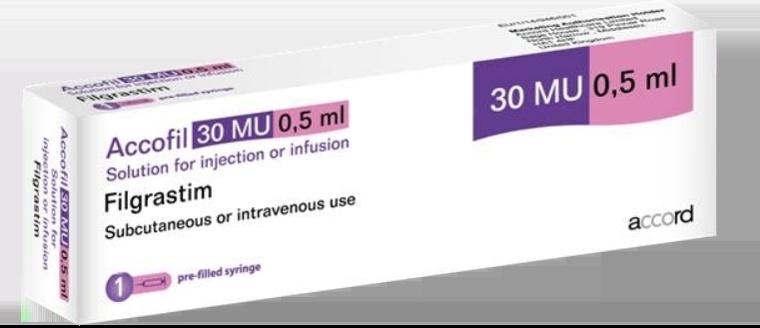
Accofil 30 IU/0.5 ml injectable solution and perfusion in pre-filled syringe


How to use Accofil 30 IU/0.5 ml injectable solution and perfusion in pre-filled syringe
Introduction
PACKAGE LEAFLET: INFORMATION FOR THE USER
Accofil 30 MU/0.5 ml (0.6 mg/ml) solution for injection and infusion in a pre-filled syringe
filgrastim
Read all of this leaflet carefully before you start using this medicine because it contains important information for you.
- Keep this leaflet, you may need to read it again.
- If you have any further questions, ask your doctor, pharmacist, or nurse.
- This medicine has been prescribed for you only. Do not pass it on to others. It may harm them, even if their signs of illness are the same as yours.
- If you get any side effects, talk to your doctor, pharmacist, or nurse. This includes any possible side effects not listed in this leaflet. See section 4.
Contents of the pack
- What is Accofil and what is it used for
- What you need to know before you use Accofil
- How to use Accofil
- Possible side effects
- Storing Accofil
- Contents of the pack and other information
1. What is Accofil and what is it used for
What is Accofil
Accofil is a white blood cell growth factor (granulocyte-colony stimulating factor) and belongs to a group of medicines called cytokines. Growth factors are proteins that are produced naturally in the body, but they can also be made using biotechnology for use as medicines. Accofil works by making the bone marrow produce more white blood cells. A reduction in the number of white blood cells (neutropenia) can occur for various reasons and makes your body less able to fight infections. Accofil stimulates the bone marrow to produce new white blood cells quickly.
Accofil can be used:
- to increase the number of white blood cells after chemotherapy to help prevent infections;
- to increase the number of white blood cells after a bone marrow transplant to help prevent infections;
- before receiving high-dose chemotherapy so that the bone marrow produces more stem cells that can be collected and given back to you after treatment. These can be collected from you or a donor. The stem cells will then return to the bone marrow and produce blood cells;
- to increase the number of white blood cells if you have severe chronic neutropenia to help prevent infections;
- in patients with advanced HIV infection to help reduce the risk of infections.
2. What you need to know before you use Accofil
Do not use Accofil
- If you are allergic to filgrastim or any of the other ingredients of this medicine (listed in section 6).
Warnings and precautions
Tell your doctor, pharmacist, or nurse before you start using Accofil:
Before starting treatment, tell your doctor if you:
- have sickle cell anaemia, Accofil may cause sickle cell crisis.
- have osteoporosis (bone disease)
Tell your doctor immediately during treatment with Accofil if you:
- have pain in the upper left side of your abdomen (stomach), pain under your left ribs or in the left shoulder tip (these can be symptoms of an enlarged spleen or possibly a ruptured spleen).
- notice unusual bleeding or bruising (these can be symptoms of a low number of platelets in your blood (thrombocytopenia) with reduced ability of your blood to clot).
- have signs of a sudden allergic reaction such as rash, itching, or hives on the skin, swelling of the face, lips, tongue, or other parts of the body, shortness of breath, wheezing (a whistling sound when you breathe), or difficulty breathing as these may be signs of a severe allergic reaction (hypersensitivity).
- experience swelling of the face or ankles, blood in your urine, or brown-coloured urine, or notice that you urinate less than usual (glomerulonefritis).
- If you have symptoms of inflammation of the aorta (the large blood vessel that carries blood from the heart to the rest of the body) this has rarely been reported in patients with cancer and in healthy donors. Symptoms may include fever, abdominal pain, general discomfort, back pain, and increased inflammatory markers. Tell your doctor if you experience these symptoms.
Loss of response to filgrastim
If you experience a loss of response or failure to maintain a response to treatment with filgrastim, your doctor will investigate the reasons including whether you have developed antibodies that neutralise the activity of filgrastim.
Your doctor may want to monitor you closely, see section 4 of the leaflet.
If you are a patient with severe chronic neutropenia, you may have an increased risk of developing blood cancer (leukaemia, myelodysplastic syndrome (MDS)). You should discuss with your doctor the risks of developing blood cancer and what tests should be done. If you develop or are likely to develop blood cancer, you should not use Accofil unless your doctor tells you to. If you are a stem cell donor, you should be between 16 and 60 years old.
Be careful with other products that stimulate white blood cells
Accofil is one of a group of products that stimulate the production of white blood cells. Your healthcare professional should always record the exact product that you are using.
Other medicines and Accofil
Tell your doctor or pharmacist if you are taking, have recently taken, or might take any other medicines.
Pregnancy and breast-feeding
Accofil has not been tested in pregnant or breast-feeding women.
Accofil is not recommended during pregnancy.
It is important to tell your doctor if:
- you are pregnant or breast-feeding;
- you think you may be pregnant; or
- you plan to become pregnant.
If you become pregnant during treatment with Accofil, tell your doctor.
Unless your doctor tells you otherwise, you should stop breast-feeding if you use Accofil.
Driving and using machines
Accofil may slightly affect your ability to drive or use machines. This medicine may cause dizziness. It is recommended that you wait and see how you feel after taking Accofil before driving or using machines.
Accofil contains sodium
This medicine contains less than 1 mmol of sodium (23 mg) per dose, which is essentially 'sodium-free'.
Accofil contains sorbitol
This medicine contains 50 mg of sorbitol in each ml. Sorbitol is a source of fructose. If you (or your child) have hereditary fructose intolerance (HFI), a rare genetic disorder, you should not receive this medicine. Patients with HFI cannot break down fructose, which may cause serious side effects.
Consult your doctor before receiving this medicine if you (or your child) have HFI or if your child cannot take sweet foods or drinks because they make them feel sick, vomit, or have unpleasant effects such as bloating, stomach cramps, or diarrhoea.
Allergy to natural rubber (latex). The needle shield of the pre-filled syringe contains dry natural rubber (a derivative of latex) which may cause a severe allergic reaction.
3. How to use Accofil
Follow the instructions for administration of this medicine exactly as told by your doctor. If you are unsure, consult your doctor, pharmacist, or nurse again.
How is Accofil administered and what dose should I use?
Accofil is usually given as a daily injection under the skin (this is called a subcutaneous injection). It can also be given as a daily slow injection into a vein (this is called an intravenous infusion). The usual dose varies depending on your condition and weight. Your doctor will tell you how much Accofil to use.
Patients having a bone marrow transplant after chemotherapy:
You will usually receive your first dose of Accofil at least 24 hours after chemotherapy and at least 24 hours after the bone marrow transplant.
You, or the persons taking care of you, can learn how to give subcutaneous injections so that you can continue treatment at home. However, you should not try to do this unless your doctor has taught you how to do it beforehand.
How long will I need to take Accofil?
You will need to take Accofil until your white blood cell count is normal. You will have regular blood tests to check the number of white blood cells in your body. Your doctor will tell you how long you need to take Accofil.
Use in children and adolescents
Accofil is used to treat children and adolescents who are receiving chemotherapy or who have a severe reduction in white blood cell count (neutropenia). The dose in children and adolescents receiving chemotherapy is the same as for adults.
Information for self-injection
This section contains information on how to inject Accofil yourself. It is important that you do not try to inject yourself without first being trained by your doctor or nurse. If you are unsure or have any questions, consult your doctor or nurse.
How do I inject Accofil?
You should inject the dose under the skin. This is called a subcutaneous injection. The injection should be given every day at about the same time.
Equipment needed
To give a subcutaneous injection, you will need:
- a pre-filled syringe of Accofil and
- a swab soaked in alcohol or similar.
What should I do before I inject Accofil?
Make sure the needle shield is still on the syringe until you are ready to inject.
- Take the pre-filled syringe of Accofil out of the refrigerator.
- Check the expiry date on the pre-filled syringe (EXP). Do not use it if the date has passed or if it has been stored out of the refrigerator for more than 15 days or has expired in any other way.
- Check the appearance of Accofil. It should be a clear, colourless liquid. If there are particles in it, do not use it.
- To make the injection more comfortable, let the pre-filled syringe stand at room temperature for 30 minutes or gently hold the syringe in your hand for a few minutes. Do not heat Accofil in any other way (for example, do notheat it in a microwave or in hot water)
- Wash your hands carefully.
- Find a comfortable and well-lit place and put everything you need within reach (the pre-filled syringe of Accofil and the swab soaked in alcohol).
How do I prepare the injection of Accofil?
Before injecting Accofil, you must:
Never use a pre-filled syringe that has been dropped onto a hard surface.
Step 1: Check the integrity of the system
Make sure the system is intact and not damaged. Do not use the product if it is damaged (if the syringe or needle shield is broken) or has loose parts, or if the needle shield is in the open position as shown in Figure 9, because this indicates that the system has already been activated. In general, the product should not be used if it does not match Figure 1. If so, the product should be discarded in a container for disposing of hazardous biological waste.
Figure 1
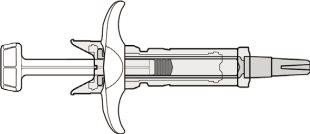
Step 2: Remove the needle shield
- Remove the needle shield as shown in Figure 2. Hold the needle shield with one hand, with the needle pointing away from you and without touching the syringe plunger. Remove the needle shield with the other hand. After doing so, discard the needle shield in a container for disposing of hazardous biological waste.
- You may notice a small air bubble in the pre-filled syringe. It is not necessary to remove the air bubble before injection. Injecting the solution with the air bubble is harmless.
- The syringe may contain more liquid than you need. Use the syringe scale as shown below to adjust the correct dose of Accofil that your doctor has prescribed. Expel any excess liquid by pushing the plunger until the syringe scale shows the prescribed dose.
- Check again that the dose of Accofil is correct.
- You can now use the pre-filled syringe.
Figure 2
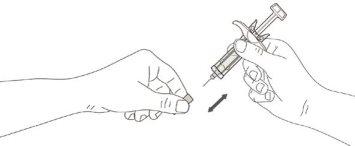
Where should I inject?
The best injection sites are:
- the top of your thighs, and
- your abdomen, except for the area around your navel (see Figure 3).
Figure 3
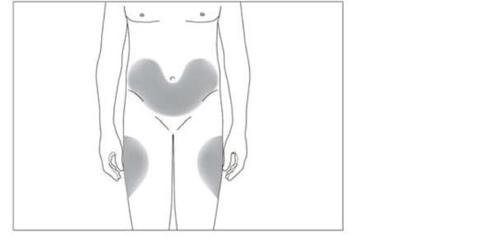
If someone else is giving you the injection, they can also use the back of your upper arms (see Figure 4).
Figure 4
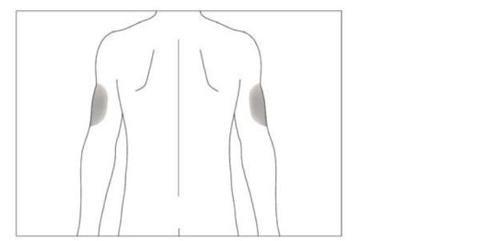
To avoid the risk of pain at one site, it is better to change the injection site every day.
Step 3: Insert the needle
- Gently pinch the skin at the injection site;
- With the other hand, insert the needle into the injection site without touching the syringe plunger (at an angle of 45 to 90°). (See Figures 6 and 7)
How do I inject?
Disinfect the injection site using a swab with alcohol and pinch the skin between your thumb and index finger, without squeezing (see Figure 5).
Figure 5
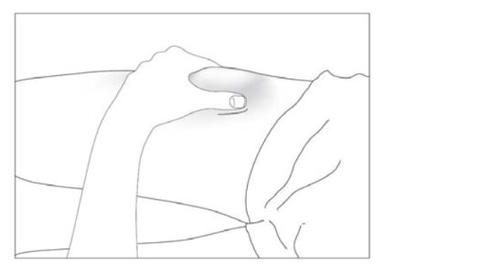
Pre-filled syringe without needle safety shield
- Insert the needle fully into the skin as your nurse or doctor has shown you (see Figure 6).
- Gently pull back the plunger to check if you have inserted the needle into a blood vessel. If you see blood in the syringe, remove the needle and insert it again at a different site.
- Keeping the skin pinched, slowly push the plunger until you have given the full dose, until the plunger can no longer move. Do not stop pressing the plunger!
- Only inject the dose prescribed by your doctor.
- After injecting the liquid, remove the needle while keeping pressure on the plunger, and then release the skin.
- Put the syringe in the special container for disposal. Each syringe is for one injection only.
Figure 6
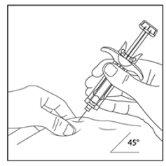
Pre-filled syringe with needle safety shield
- Insert the needle fully into the skin as your nurse or doctor has shown you.
- Gently pull back the plunger to check if you have inserted the needle into a blood vessel. If you see blood in the syringe, remove the needle and insert it again at a different site.
- Inject only the dose that your doctor has told you to, following the instructions below.
Figure 7
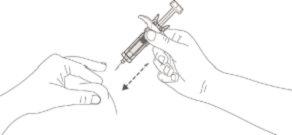
Step 4: Injection
Place your thumb on the end of the plunger. Press the plunger rod and push firmlyto ensure that the syringe is empty (see Figure 8). Also, hold the skin firmly until the injection is complete.
Figure 8
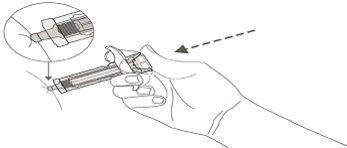
Step 5: Protection against accidental needlestick injury
The safety system is activated when the plunger is pushed to the end:
- Without moving the syringe, slowly lift your thumb off the end of the plunger;
- The plunger will rise with your thumb and the spring will retract the needle from the injection site into the needle shield (see Figure 9).
Figure 9
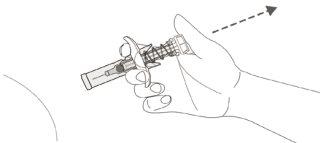
Remember
If you have any doubts, ask your doctor or nurse for help and advice.
How to dispose of used syringes
The needle shield prevents needlestick injury after use, and therefore, no special precautions are needed for disposal. Dispose of the syringe as instructed by your doctor, nurse, or pharmacist.
If you use more Accofil than you should
Do not increase the dose that your doctor has given you. If you think you have injected more than you should, contact your doctor as soon as possible.
If you forget to use Accofil
If you have missed an injection or injected too little, contact your doctor to discuss when you should inject the next dose as soon as possible. Do not take a double dose to make up for a missed injection.
If you have any other questions about the use of this medicine, ask your doctor, pharmacist, or nurse.
4. Possible Adverse Effects
Like all medicines, this medicine can cause adverse effects, although not all people suffer from them.
Please inform your doctor immediatelyduring treatment:
- If you experience an allergic reaction with weakness, drop in blood pressure, difficulty breathing, swelling in the face (anaphylaxis), skin rash, hives (urticaria), swelling in the face, lips, mouth, tongue, or throat (angioedema), and shortness of breath (dyspnea).
- If you experience kidney injury (glomerulonephritis). Kidney injuries have been observed in patients who received Accofil. Call your doctor immediately if you experience swelling in the face or ankles, blood in the urine, or urine of a brown color, or if you notice that you urinate less than usual.
- If you experience cough, fever, and difficulty breathing (dyspnea), as this may be a sign of acute respiratory distress syndrome (ARDS).
- If you notice pain in the upper left part of the abdomen, pain below the left thoracic cavity, or pain in the tip of the shoulder, as there may be a problem with your spleen (splenomegaly or spleen rupture).
- If you are being treated for severe chronic neutropenia and have blood in the urine (hematuria). Your doctor may analyze your urine periodically if you experience this adverse effect or if proteins are found in your urine (proteinuria).
- If you experience any of the following adverse effects or a combination of them: inflammation or swelling, which may be associated with reduced frequency of urination, difficulty breathing, abdominal swelling, and a feeling of fullness, and a general feeling of fatigue. These symptoms usually develop rapidly.
These could be symptoms of a condition called "capillary leak syndrome", which causes blood to leak from the small blood vessels in the body and requires urgent medical attention.
- If you experience a combination of any of the following symptoms:
- fever or chills, or feeling very cold, high heart rate, confusion or disorientation, shortness of breath, severe pain or discomfort, and sweaty and sticky skin.
These could be symptoms of a condition called "sepsis" (also called "blood poisoning"), a severe infection with an inflammatory response throughout the body that can be life-threatening and requires urgent medical attention.
A very common adverse effect with the use of Accofil is pain in the muscles or bones (musculoskeletal pain), which can be relieved by taking conventional painkillers. In patients undergoing stem cell or bone marrow transplantation, graft-versus-host disease (GVHD) may occur: this is a reaction of the donor cells against the patient receiving the transplant; signs and symptoms include skin rash on the palms of the hands and soles of the feet, and ulcers and sores in the mouth, intestine, liver, skin, or eyes, lungs, vagina, and joints.
In healthy stem cell donors, an increase in white blood cells (leukocytosis) and a decrease in platelets that reduces the ability of the blood to clot (thrombocytopenia) may be observed; your doctor will monitor these reactions.
Very Common Adverse Effects(may affect more than 1 in 10 people):
- vomiting
- nausea
- hair loss or weakening (alopecia)
- fatigue
- pain and swelling of the lining of the digestive tract (mucosal inflammation)
- decrease in platelets, which reduces the ability of the blood to clot (thrombocytopenia)
- low red blood cell count (anemia)
- fever (pyrexia)
- headache
- diarrhea
Common Adverse Effects(may affect up to 1 in 10 people):
- lung inflammation (bronchitis)
- upper respiratory tract infection
- urinary tract infection
- decreased appetite
- difficulty sleeping (insomnia)
- dizziness
- reduced sensation, especially in the skin (hypoesthesia)
- tingling or numbness of the hands or feet (paresthesia)
- low blood pressure (hypotension)
- high blood pressure (hypertension)
- cough
- coughing up blood (hemoptysis)
- pain in the mouth and throat (oropharyngeal pain)
- nosebleeds (epistaxis)
- constipation
- oral pain
- enlargement of the liver (hepatomegaly)
- rash
- redness of the skin (erythema)
- muscle spasms
- pain when urinating (dysuria)
- chest pain
- pain
- generalized weakness (asthenia)
- feeling unwell in general (general malaise)
- swelling of the hands and feet (peripheral edema)
- increase in certain blood enzymes
- changes in blood chemistry
- transfusion reaction
Uncommon Adverse Effects(may affect up to 1 in 100 people):
- increase in white blood cells (leukocytosis)
- allergic reaction (hypersensitivity)
- rejection of the transplanted bone marrow (graft-versus-host disease)
- high levels of uric acid in the blood that can cause gout (hyperuricemia)
- liver damage caused by blockage of the small veins within the liver (veno-occlusive disease)
- the lungs do not function as they should, causing shortness of breath (respiratory failure)
- swelling or fluid in the lungs (pulmonary edema)
- inflammation of the lungs (interstitial pneumonitis)
- radiographic abnormality of the lungs (pulmonary infiltration)
- bleeding in the lung (pulmonary hemorrhage)
- lack of oxygen absorption in the lungs (hypoxia)
- scaly skin rash (maculopapular rash)
- disease that causes bones to be less dense, making them weaker, more fragile, and more likely to break (osteoporosis)
- reaction at the injection site
Rare Adverse Effects(may affect up to 1 in 1,000 people):
- inflammation of the aorta (the large blood vessel that carries blood from the heart to the rest of the body), see section 2.
- severe pain in bones, chest, intestine, or joints (sickle cell crisis)
- sudden allergic reaction with risk of death (anaphylactic reaction)
- pain and swelling of the joints, similar to gout (pseudogout)
- change in how the body regulates body fluids, which can cause swelling (changes in volemia)
- inflammation of the blood vessels in the skin (cutaneous vasculitis)
- painful purple-colored lesions with relief on the extremities, and sometimes on the face and neck, along with fever (Sweet's syndrome)
- worsening of rheumatoid arthritis
- rare change in urine
- decrease in bone density
- formation of blood cells outside the bone marrow (extramedullary hematopoiesis)
Reporting Adverse Effects
If you experience any type of adverse effect, consult your doctor or nurse, even if it is a possible adverse effect that is not listed in this leaflet. You can also report them directly through the national reporting system included in Appendix V. By reporting adverse effects, you can contribute to providing more information on the safety of this medicine.
5. Storage of Accofil
Keep this medicine out of the sight and reach of children.
Do not use this medicine after the expiration date that appears on the carton and on the pre-filled syringe after CAD. The expiration date is the last day of the month.
Store in a refrigerator (between 2°C-8°C). Do not freeze.
The syringe can be removed from the refrigerator and left at room temperature (but at a temperature not above 25°C) for a single period of up to a maximum of 15 days and never beyond the expiration date on the label. After this period, the medicine should not be refrigerated again and should be discarded.
Store the pre-filled syringe in the outer packaging to protect it from light.
Do not use Accofil if you notice turbidity or discoloration or if there are particles in it.
Do not put the cap on used needles, as you may accidentally prick yourself. Medicines should not be thrown away through drains or into the trash. Ask your pharmacist how to dispose of medicines that are no longer needed. This will help protect the environment.
6. Package Contents and Additional Information
Composition of Accofil
- The active ingredient is filgrastim. Each pre-filled syringe contains 30 MU (300 micrograms) of filgrastim in 0.5 ml, which corresponds to 0.6 mg/ml.
- The other ingredients are acetic acid, sodium hydroxide, sorbitol (E420), polysorbate 80, and water for injectable preparations.
Appearance of the Product and Package Contents
Accofil is a clear and colorless solution for injection or infusion in a pre-filled syringe marked with 1/40 printed marks of 0.1 ml to 1 ml on the syringe cylinder with an injection needle. Each pre-filled syringe contains 0.5 ml of solution.
Accofil is available in packs of 1, 3, 5, 7, and 10 pre-filled syringes, with or without a fixed safety needle protector and alcohol-impregnated swabs.
Not all pack sizes may be marketed.
Marketing Authorization Holder
Accord Healthcare S.L.U.
World Trade Center, Moll de Barcelona, s/n,
Edifici Est 6ª planta,
08039 Barcelona,
Spain
Manufacturer
Accord Healthcare Polska Sp.z o.o.,
ul. Lutomierska 50, 95-200 Pabianice, Poland
You can request more information about this medicine by contacting the local representative of the marketing authorization holder:
AT / BE / BG / CY / CZ / DE / DK / EE / FI / FR / HR / HU / IE / IS / IT / LT / LV / LU / MT / NL / NO / PT / PL / RO / SE / SI / SK / ES
Accord Healthcare S.L.U.
Tel: +34 93 301 00 64
EL
Win Medica A.E.
Tel: +30 210 7488 821
Date of the Last Revision of this Leaflet:
Detailed information on this medicine is available on the European Medicines Agency website: https://www.ema.europa.eu
---------------------------------------------------------------------------------------------------------------
The following information is intended only for healthcare professionals:
Accofil does not contain preservatives. Due to a possible risk of microbial contamination, Accofil pre-filled syringes are for single use only.
Accidental exposure to freezing temperatures for up to a maximum of 48 hours does not affect the stability of Accofil. If exposure exceeds 48 hours or if it is frozen more than once, Accofil SHOULD NOT be used.
In order to improve the traceability of granulocyte colony-stimulating factors, the name of the product (Accofil) and the batch number of the product administered should be clearly recorded in the patient's medical record.
Accofil should not be diluted with sodium chloride. This medicine should not be mixed with other medicines except those mentioned below. The dilution of filgrastim may be adsorbed by glass and plastic materials except if diluted as mentioned below.
If necessary, Accofil can be diluted in 5% glucose. Dilution to a final concentration of less than 0.2 MU (2 μg) per ml is not recommended at any time.
The solution should be inspected visually before use. Only clear solutions without particles should be used.
For patients treated with filgrastim diluted to concentrations below 1.5 MU (15 μg) per ml, human serum albumin (HSA) should be added to a final concentration of 2 mg/ml. Example: in a final injection volume of 20 ml, total filgrastim doses below 30 MU (300 μg) should be administered with the addition of 0.2 ml of 20% human albumin solution (200 mg/ml).
When diluted in 5% glucose, Accofil is compatible with glass and a variety of plastics such as PVC, polyolefin (a copolymer of polypropylene and polyethylene), and polypropylene.
After dilution
The chemical and physical stability of the diluted infusion solution has been demonstrated for up to 30 hours at 25°C ± 2°C. From a microbiological point of view, the product should be used immediately. If not used immediately, the times and conditions of storage prior to use are the responsibility of the user and should not normally exceed 30 hours at 25°C ± 2°C, unless the dilution has taken place in controlled and validated aseptic conditions.
Use of the pre-filled syringe with safety needle protector
The safety protector covers the needle after injection to prevent accidental needlestick injuries. This does not affect the normal functioning of the syringe. Press the plunger rod and push firmlyat the end of the injection to ensure that the syringe has been fully emptied. Hold the skin firmly until the injection is complete. Keep the syringe still and slowly lift your thumb from the plunger rod. The plunger rod will move up with your thumb, and the spring will retract the needle from the site, within the safety needle protector.
Use of the pre-filled syringe without safety needle protector
Administer the dose following the standard protocol.
Never use a pre-filled syringe that has been dropped onto a hard surface.
Disposal
Disposal of unused medicine and all materials that have come into contact with it will be carried out in accordance with local regulations.
- Country of registration
- Active substance
- Prescription requiredYes
- Manufacturer
- This information is for reference only and does not constitute medical advice. Always consult a licensed doctor before taking any medication. Oladoctor is not responsible for medical decisions based on this content.
- Alternatives to Accofil 30 IU/0.5 ml injectable solution and perfusion in pre-filled syringeDosage form: INJECTABLE, 12 IU/0.2 mlActive substance: filgrastimManufacturer: Accord Healthcare S.L.U.Prescription requiredDosage form: INJECTABLE, 0.3 mg / prefilled syringeActive substance: filgrastimManufacturer: Accord Healthcare S.L.U.Prescription requiredDosage form: INJECTABLE, 30 IU/0.5 mlActive substance: filgrastimManufacturer: Accord Healthcare S.L.U.Prescription required
Alternatives to Accofil 30 IU/0.5 ml injectable solution and perfusion in pre-filled syringe in other countries
The best alternatives with the same active ingredient and therapeutic effect.
Alternative to Accofil 30 IU/0.5 ml injectable solution and perfusion in pre-filled syringe in Польша
Alternative to Accofil 30 IU/0.5 ml injectable solution and perfusion in pre-filled syringe in Украина
Online doctors for Accofil 30 IU/0.5 ml injectable solution and perfusion in pre-filled syringe
Discuss dosage, side effects, interactions, contraindications, and prescription renewal for Accofil 30 IU/0.5 ml injectable solution and perfusion in pre-filled syringe – subject to medical assessment and local rules.





